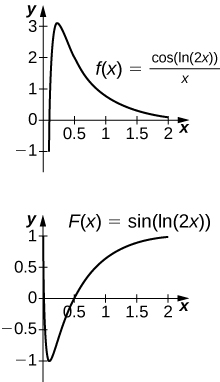| << Chapter < Page | Chapter >> Page > |
In the following exercises, find the antiderivative using the indicated substitution.
In the following exercises, use a suitable change of variables to determine the indefinite integral.
In the following exercises, use a calculator to estimate the area under the curve using left Riemann sums with 50 terms, then use substitution to solve for the exact answer.
In the following exercises, use a change of variables to evaluate the definite integral.
In the following exercises, evaluate the indefinite integral with constant using u -substitution. Then, graph the function and the antiderivative over the indicated interval. If possible, estimate a value of C that would need to be added to the antiderivative to make it equal to the definite integral with a the left endpoint of the given interval.
[T] on

The antiderivative is
Since the antiderivative is not continuous at
one cannot find a value of
C that would make
work as a definite integral.
If in what can you say about the value of the integral?
Is the substitution in the definite integral okay? If not, why not?
No, because the integrand is discontinuous at
In the following exercises, use a change of variables to show that each definite integral is equal to zero.
Show that the average value of over an interval is the same as the average value of over the interval for
Setting and gets you
Find the area under the graph of between and where and is fixed, and evaluate the limit as
Find the area under the graph of between and where and is fixed. Evaluate the limit as
As the limit is if and the limit diverges to +∞ if
The area of a semicircle of radius 1 can be expressed as Use the substitution to express the area of a semicircle as the integral of a trigonometric function. You do not need to compute the integral.
The area of the top half of an ellipse with a major axis that is the x -axis from to a and with a minor axis that is the y -axis from to b can be written as Use the substitution to express this area in terms of an integral of a trigonometric function. You do not need to compute the integral.
[T] The following graph is of a function of the form Estimate the coefficients a and b , and the frequency parameters n and m . Use these estimates to approximate
![A graph of a function of the given form over [0, 2pi], which has six turning points. They are located at just before pi/4, just after pi/2, between 3pi/4 and pi, between pi and 5pi/4, just before 3pi/2, and just after 7pi/4 at about 3, -2, 1, -1, 2, and -3. It begins at the origin and ends at (2pi, 0). It crosses the x axis between pi/4 and pi/2, just before 3pi/4, pi, just after 5pi/4, and between 3pi/2 and 4pi/4.](/ocw/mirror/col11964/m53634/CNX_Calc_Figure_05_05_201.jpg)
[T] The following graph is of a function of the form Estimate the coefficients a and b and the frequency parameters n and m . Use these estimates to approximate
![The graph of a function of the given form over [0, 2pi]. It begins at (0,1) and ends at (2pi, 1). It has five turning points, located just after pi/4, between pi/2 and 3pi/4, pi, between 5pi/4 and 3pi/2, and just before 7pi/4 at about -1.5, 2.5, -3, 2.5, and -1. It crosses the x axis between 0 and pi/4, just before pi/2, just after 3pi/4, just before 5pi/4, just after 3pi/2, and between 7pi/4 and 2pi.](/ocw/mirror/col11964/m53634/CNX_Calc_Figure_05_05_202.jpg)

Notification Switch
Would you like to follow the 'Calculus volume 1' conversation and receive update notifications?